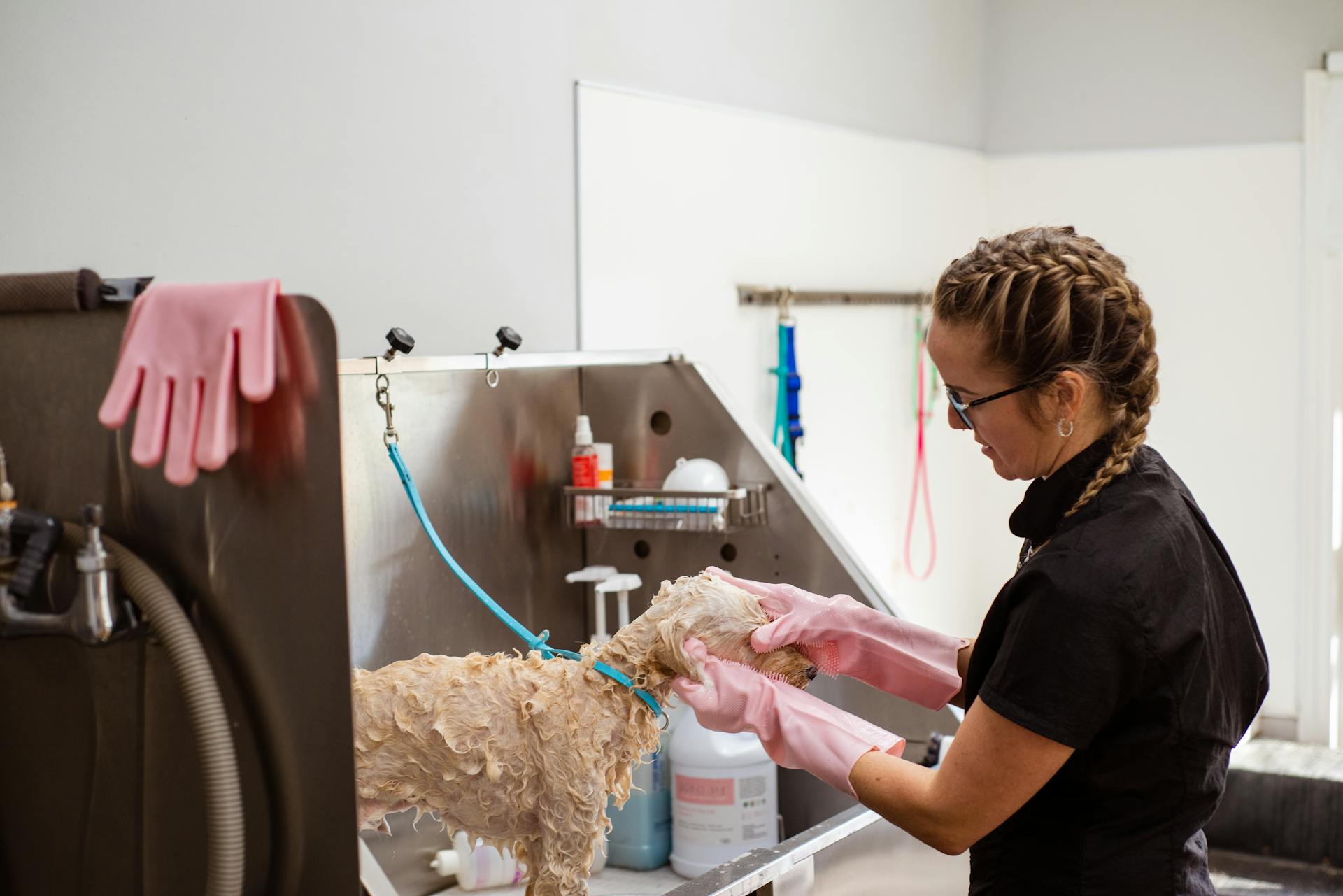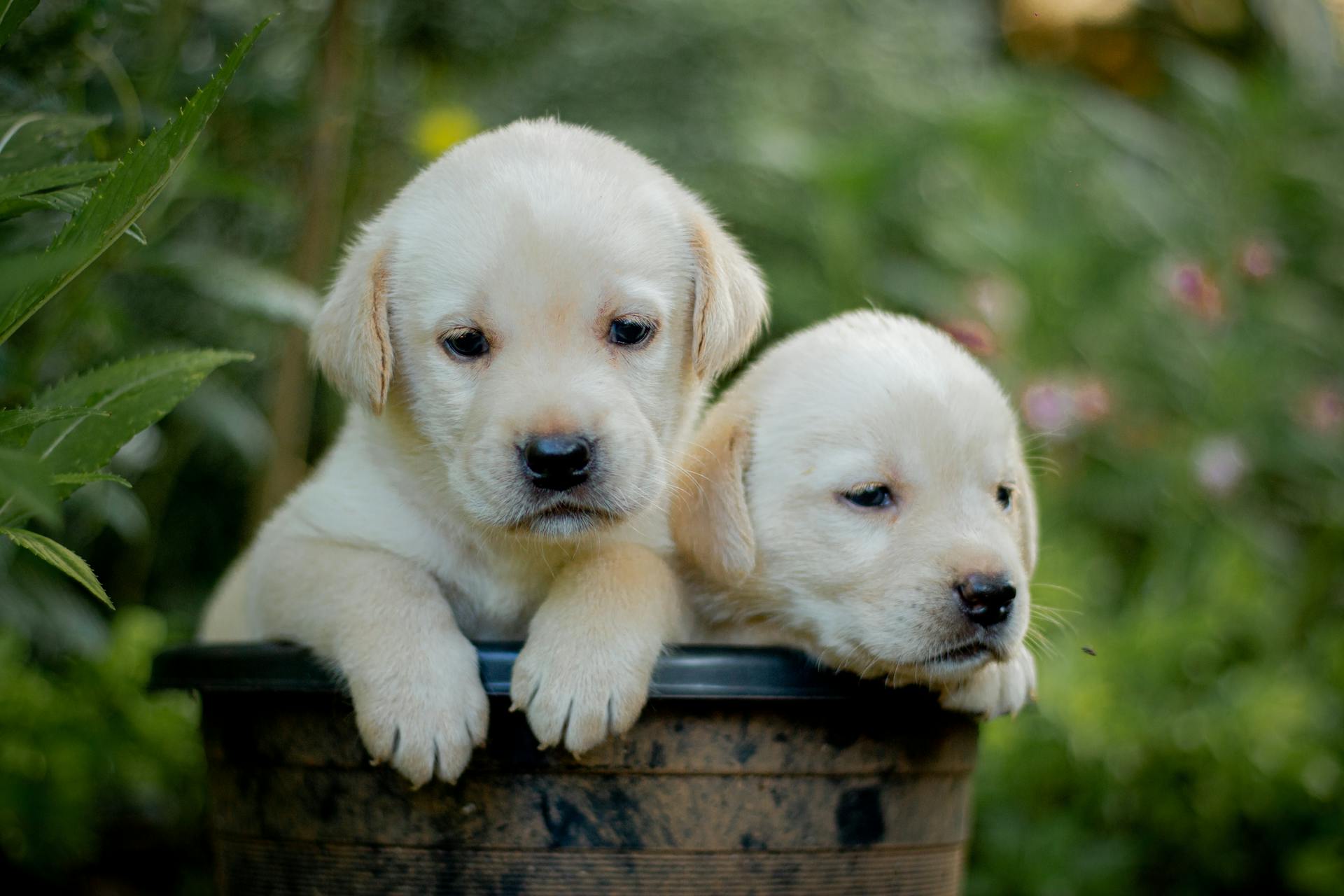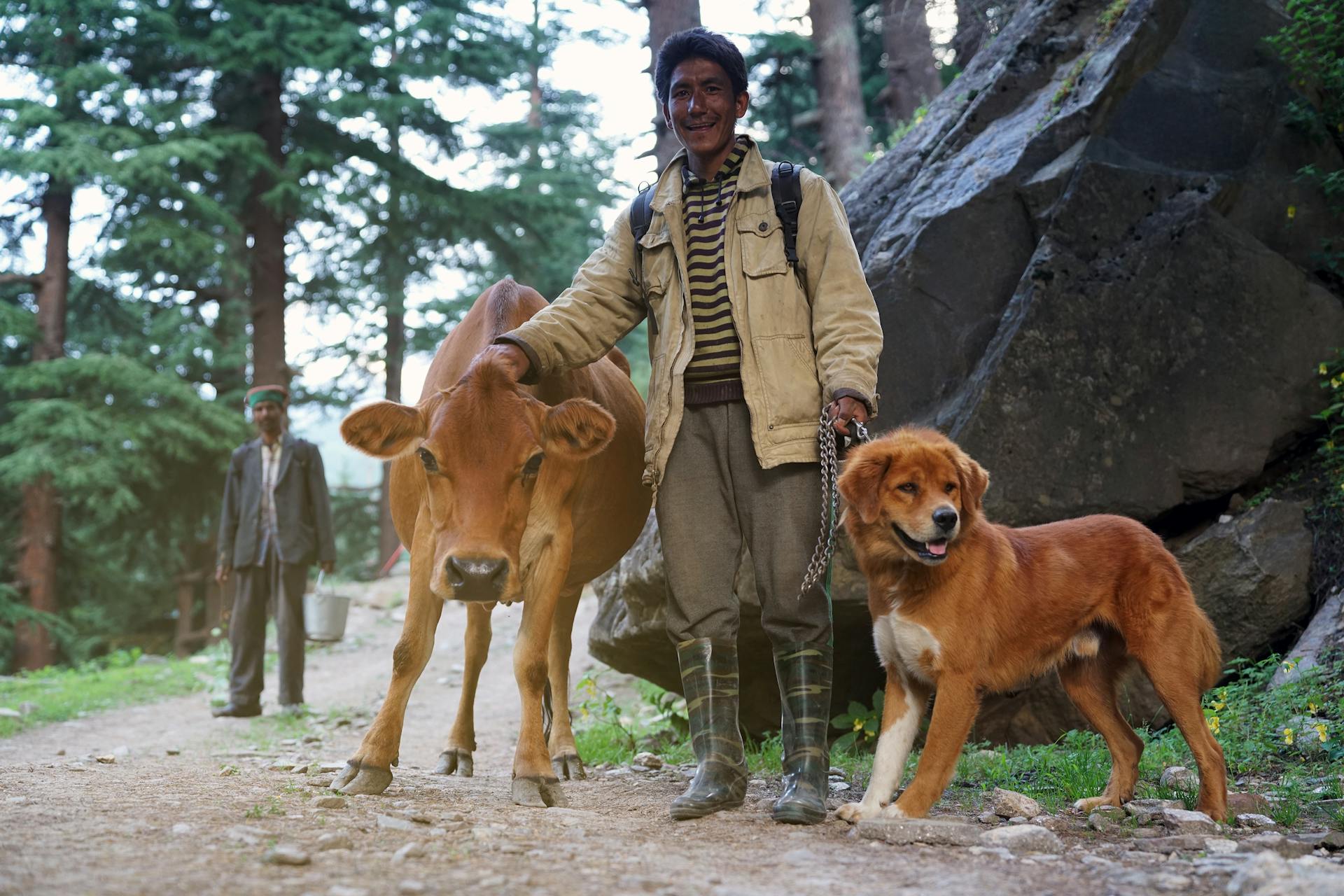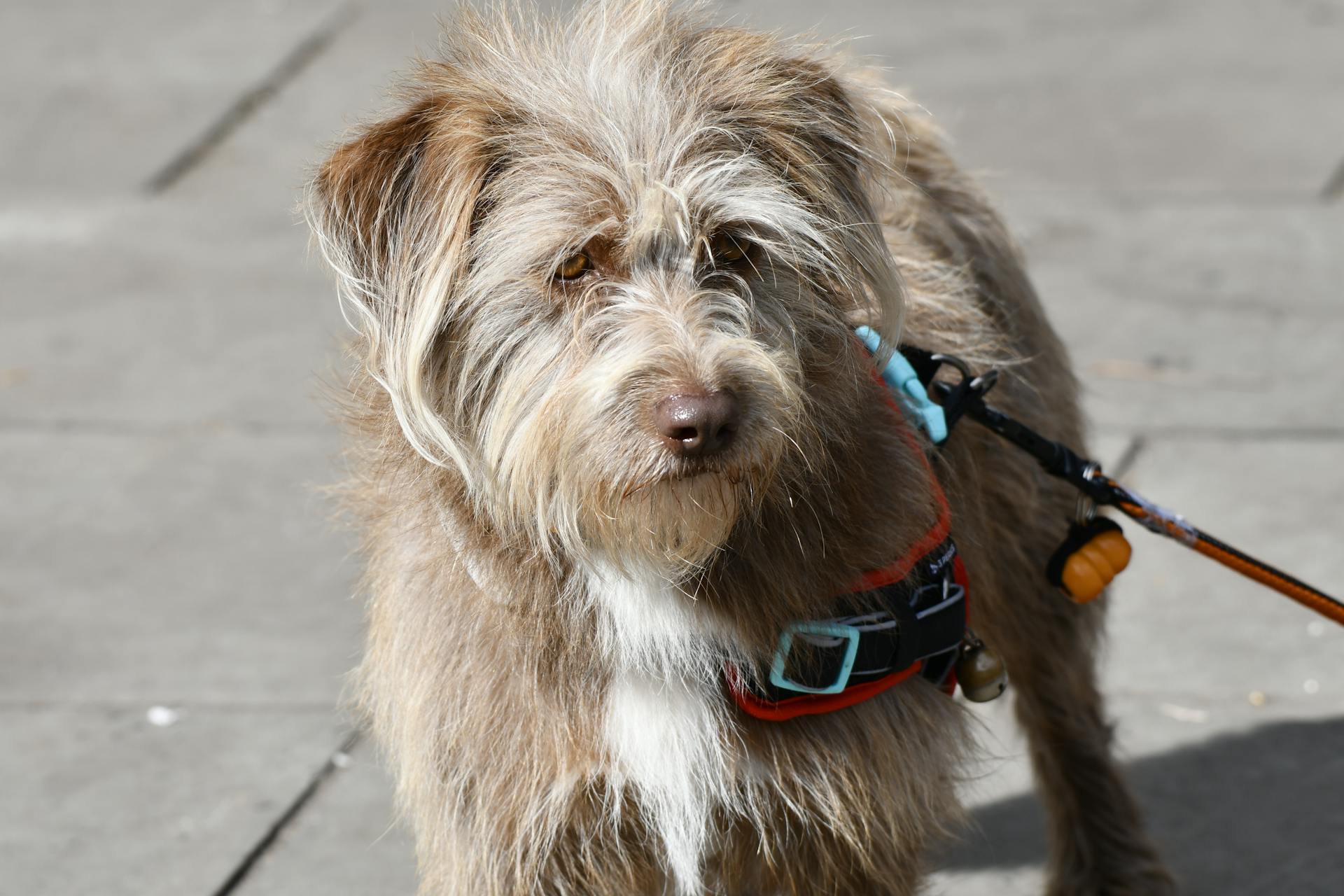
The Kooikerhondje is a small, energetic dog breed that originated in the Netherlands.
They are known for their distinctive orange and white coat, which requires regular grooming to prevent matting and tangling.
These dogs are relatively small, weighing between 20-30 pounds and standing about 15-17 inches tall at the shoulder.
They are a relatively healthy breed, but like all breeds, they can be prone to certain health issues, such as hip dysplasia and eye problems.
Appearance
The Kooikerhondje is a small dog with a big personality, standing between 13.5 to 17.5 inches tall for males and 13.5 to 16.5 inches for females. They have a moderate bone structure and a gentle, alert expression.
Their coat is a stunning combination of orange-red and white, with distinct patches of clear orange-red on pure white. The color should be predominant on the back, with the chest, belly, blaze, and majority of the legs and tail white. Black ears and a black tail ring are also a part of their signature look.
Here are some key physical traits of the Kooikerhondje:
- Ears: Adorned with dark-tipped hair, known as "earrings"
- Eyes: Almond-shaped, dark brown, and friendly
- Nose: Tiny black and cute
- Coat: Medium-length, slightly wavy, and soft
- Coat color: Orange-red with white patches
- Tail: Well-feathered with a white plume
Size
The Kooikerhondje's size is quite compact, with males standing 14.5 to 17.5 inches tall at the withers in the United States.
For females, the height is slightly shorter, ranging from 13.5 to 16.5 inches at the withers in the US.
The breed standard allows for a range of 38 to 41 cm for males, and 36 to 39 cm for females, when measured at the withers.
Kooikers typically weigh between 20 to 25 pounds, which is a relatively light weight for a sporting dog.
Their overall proportion is off-square, giving them a unique and athletic appearance.
Distinctive Physical Traits
The Nederlandse Kooikerhondje is a stunning breed with a unique appearance that's hard to resist. Their coat is a beautiful combination of orange-red and white, with a crisp autumnal color that's simply striking.
Their ears may be delicate, but they're adorned with dark-tipped hair, known as "earrings", which add a touch of elegance to their overall look. These earrings are a distinctive feature of the breed.
Their almond-shaped, dark brown eyes are friendly, alert, and inquisitive, giving them an eager expression that's impossible to ignore. It's as if they're always asking, "What can I do for you?"
Their nose is tiny and black, a classic feature of the breed that's both cute and functional. As a scent hound, the Nederlandse Kooikerhondje excels at sniffing out its quarry.
Their coat is medium-length, slightly wavy, and incredibly soft to the touch. It's a joy to nuzzle up to their fur, especially around the hug zone.
Their tail is a lavishly feathered, white plume that swishes happily to express their love for their family. It's a signature trait of the breed that's impossible to miss.
Here are the distinctive physical traits of the Nederlandse Kooikerhondje at a glance:
Overall, the Nederlandse Kooikerhondje is a stunning breed with a unique appearance that's sure to capture your heart.
Health
The Kooikerhondje is a relatively healthy breed, but like all dogs, they can be susceptible to certain health conditions. These include hereditary diseases such as inflammatory myopathy, type III von Willebrand's disease, necrotising myelopathy, renal dysplasia, patellar luxation, and ataxia.
According to a Dutch study, patellar luxation was prevalent in 24% of Kooikerhondjes scanned, although the prevalence has fallen over time.
Some key health considerations for Kooikerhondjes include von Willebrand’s Disease, a bleeding disorder caused by a deficiency in a specific blood clotting protein, and hip dysplasia, a genetic condition where the hip joint doesn’t develop correctly.
A Dutch study of 842 dogs found that patellar luxation was prevalent in 24% of Kooikerhondjes scanned, although the prevalence has fallen over time.
Kooikerhondjes can also be prone to autoimmune disorders, ear infections, and epilepsy. Regular veterinary care, including vaccinations, preventive measures against parasites, and dental care, can help maintain their health and well-being.
Here are some common health issues that can affect Kooikerhondjes:
- Von Willebrand’s Disease: a bleeding disorder caused by a deficiency in a specific blood clotting protein.
- Cataracts: can develop in the eyes over time and may require surgical intervention if they impair vision.
- Hip Dysplasia: a genetic condition where the hip joint doesn’t develop correctly, potentially leading to arthritis and mobility issues.
- Patellar Luxation: a condition involving the dislocation of the kneecap and can lead to lameness and discomfort.
- Autoimmune Disorders: some Kooikerhondjes may be prone to autoimmune diseases like autoimmune thyroiditis or immune-mediated hemolytic anemia.
- Ear Infections: due to their floppy ears and active outdoor lifestyle, Kooikerhondjes can be prone to ear infections.
- Epilepsy: some individuals may develop epilepsy, a neurological disorder that can cause seizures.
History and Origins
The Kooikerhondje has a rich history dating back to the 17th century, with some historians believing they may have played a part in the development of the Nova Scotia Duck Tolling Retriever.
The breed was originally bred for duck hunting in the Netherlands, with their name derived from the Dutch word "kooiker", meaning "duck decoy."
In the 17th century, Kooikers were used by hunters to lure ducks into specially designed traps, known as "eendenkooi" or "duck cages."
These dogs were expertly trained to lure ducks into the traps, and their agility, intelligence, and distinctive facial pattern made them skilled decoy dogs.
The breed nearly became extinct during World War I, but was saved by Baroness von Hardenbroek van Ammerstol in the late 1930s, who sought out the little dogs throughout the Dutch countryside and brought them back from the brink of extinction.
The Dutch Kennel Club officially recognized the Kooiker in 1971, and the breed has since been recognized by the UK Kennel Club and the American Kennel Club.
Today, the Kooikerhondje is still used for duck hunting and conservation efforts in the Netherlands, and is also kept as a beloved companion in homes around the world.
The breed's original function as a decoy dog is still seen in their behavior today, and they are known for their playful and energetic personalities.
A fresh viewpoint: Tibetan Mastiff Largest Dog Breed
Overview
The Kooikerhondje is a cheerful spaniel originating from the Netherlands, appearing in paintings as far back as the sixteenth century.
They were bred to serve as a hunting dog, luring ducks within range for shooting or tagging. This skill is likely where they got their name, although it doesn't translate to "cookie dog" as some might think.
The Kooiker is a friendly and good-natured breed, making them an excellent family companion. They're also naturally alert and athletic, which makes them a great fit for activities like agility and flyball.
Their exercise needs are adaptable, so they can thrive with either a long, slow stroll or a strenuous hike. Just be sure to condition them first before putting them through any heavy exercise.
The Kooiker is smart and willing to learn, so it's essential to start training early. Introducing them to cats or other dogs when they're young will also help them get along just fine.
Care and Feeding
Caring for a Kooikerhondje requires attention to their physical and mental needs. Daily walks, play sessions, and interactive toys are essential to keep them mentally and physically engaged.
Their distinctive orange-red and white coat requires regular brushing to remove loose hair, particularly during shedding seasons. Regular ear cleaning and inspection are also necessary to prevent ear infections.
To ensure their overall health, provide a balanced diet that meets their nutritional needs, and adjust portion sizes according to their age, activity level, and health status. Fresh water should always be available.
Care
To keep your Kooikerhondje happy and healthy, regular exercise is a must. Daily walks and play sessions are essential to keep them physically and mentally engaged.
Their distinctive orange-red and white coat requires regular brushing to remove loose hair, especially during shedding seasons. A good brushing every week should keep their coat in good condition.
Kooikerhondjes are intelligent and eager to please, but can also be independent, so early and consistent positive reinforcement-based training is beneficial. Socialization with people and other animals helps ensure they grow into well-adjusted adults.
Take a look at this: German Shorthaired Pointer Free to Good Home

These dogs thrive on companionship and should not be left alone for extended periods. Their friendly and affectionate nature makes them great family pets, and they generally get along well with children and other animals.
To prevent ear infections, check and clean your dog's ears routinely. Their long ears are more susceptible to infections, so regular ear cleaning is a must.
A high-quality diet is crucial for your Kooikerhondje's overall health. Follow the feeding guidelines provided on the dog food packaging and adjust portion sizes accordingly to prevent overfeeding and obesity.
Regular feeding schedules and portion control will help keep your Kooikerhondje in optimal health. Treats should make up no more than 10% of a dog's calories to prevent them from becoming overweight.
Here's a quick rundown of the essential grooming tasks:
- Brush your Kooikerhondje once a week, and more often during shedding season.
- Trim their nails periodically to prevent pain and other problems.
- Check and clean their ears regularly to prevent infections.
- Establish an at-home dental care routine that includes regular teeth brushing and dental chews or treats.
By following these simple care tips, you'll be well on your way to raising a happy and healthy Kooikerhondje.
Training
Training a Kooikerhondje requires patience, positive reinforcement, and structure. They thrive on mental and physical stimulation, so training sessions should be fun and engaging.

Kooikerhondjes are highly intelligent and eager to please, making them a breeze to train. With consistent positive reinforcement, they'll learn quickly and efficiently.
To keep their lively spirits high, you'll need to mix up training activities and engage them with challenging tasks. This could be as simple as hiding treats for them to find or playing fetch in the backyard.
Their independent nature means they can be prone to wandering off on "sniffaris", so be sure to include plenty of structure and boundaries in their training. Consistent obedience classes and puppy socialization are a must.
Positive motivations like praise, toys, and treats will be essential in keeping your Kooiker on track. Everyone in the household should be included in training, as it's a team effort to harness their intelligence and make training matter.
Kooikerhondjes excel in scent work, agility, and obedience, so consider enrolling them in dog sports or classes that cater to their natural abilities. With the right approach and plenty of patience, you'll be rewarded with a lifetime of successes and laughs.
Frequently Asked Questions
How much does a Kooikerhondje puppy cost?
A Kooikerhondje puppy typically costs between $2,500 and $4,000 in the US. If you're considering bringing one home, learn more about this charming breed and its needs.
Are Kooikerhondje aggressive?
Kooikerhondjes can be prone to aggression, especially when defending resources or interacting with other dogs. Proper training, exercise, and mental stimulation can help manage these tendencies.
What does Kooiker mean in Dutch?
In Dutch, "Kooiker" refers to a hunter who uses a specific technique to catch birds. The word is derived from "kooi," meaning cage or enclosure, and "ker," meaning hunter.
Are Kooikerhondje rare?
Yes, the Kooikerhondje is a rare breed, but its unique role in conservation efforts is helping to preserve the Netherlands' native wetlands and culture.
Is een kooiker een Spaniel?
Ja, een kooikerhondje is een type van spaniël. Het is een kleine hondsoort die oorspronkelijk werd gebruikt voor eendenjacht.
Featured Images: pexels.com


